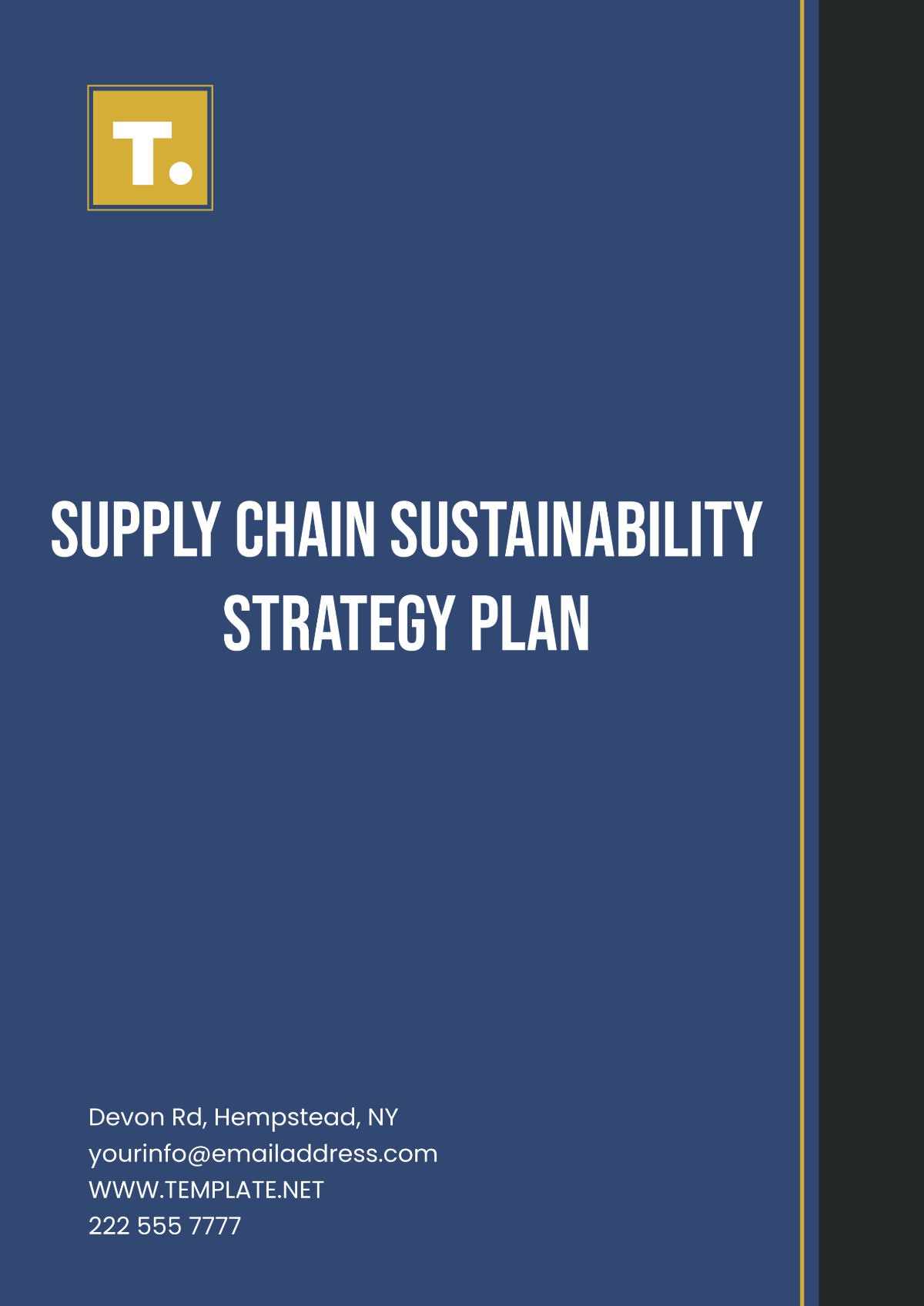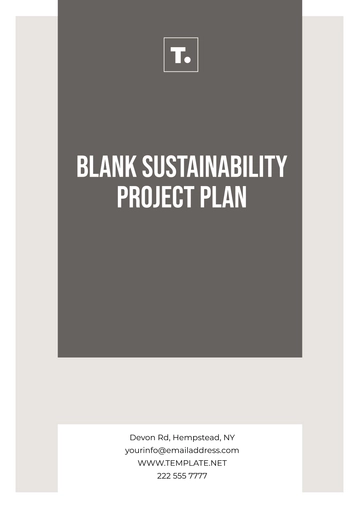Free Supply Chain Sustainability Strategy Plan

Date: [Date]
Prepared By: [Your Name]
I. Executive Summary
The Supply Chain Sustainability Strategy Plan outlines the commitment to integrating sustainability principles into the organization’s supply chain management processes. It aims to reduce environmental impact, improve social responsibility, and ensure economic performance across all stages of the supply chain. This strategy will guide the organization in selecting suppliers, managing resources, and promoting sustainable practices throughout the entire supply chain.
II. Purpose and Objectives
Purpose: To ensure the supply chain is sustainable.
Objectives:
Reduce carbon emissions and energy consumption in the supply chain.
Promote ethical labor practices and improve working conditions.
Optimize resource use and reduce waste generation.
Collaborate with suppliers and partners to enhance sustainability.
Integrate sustainable sourcing practices to improve long-term profitability.
Achieve compliance with local and international sustainability regulations and certifications.
III. Scope
The strategy applies to all stages of the supply chain:
Sourcing and Procurement: Engage suppliers who meet sustainability standards.
Production and Manufacturing: Ensure sustainable production processes, focusing on resource efficiency and waste reduction.
Transportation and Distribution: Implement efficient logistics and transportation options with a low environmental footprint.
Retail and End-Use: Provide customers with environmentally-friendly products and services.
Post-Consumer: Encourage product recycling and take-back programs for end-of-life products.
IV. Key Areas of Focus
Environmental Sustainability:
Energy Efficiency: Optimize energy use in production and transportation.
Waste Reduction: Implement recycling, reuse, and responsible waste disposal practices.
Carbon Footprint Reduction: Set measurable goals to reduce emissions, focusing on renewable energy and fuel-efficient transportation.
Sustainable Sourcing: Choose raw materials and resources that are responsibly sourced.
Social Responsibility:
Fair Labor Practices: Ensure that suppliers adhere to ethical labor practices, such as fair wages, safe working conditions, and employee rights.
Community Engagement: Invest in initiatives that support local communities and promote human development.
Health and Safety: Provide a safe environment for workers and implement health and safety regulations throughout the supply chain.
Economic Sustainability:
Cost Efficiency: Streamline operations to reduce costs while maintaining quality.
Long-Term Profitability: Focus on sustainable growth by adopting circular economy principles.
Innovation and Technology: Invest in advanced technologies that optimize supply chain processes and reduce environmental impact.
V. Strategy Implementation
Supplier Engagement:
Develop a supplier code of conduct that outlines sustainability expectations.
Collaborate with key suppliers to set mutual sustainability goals and objectives.
Conduct regular supplier audits and assessments to ensure compliance with sustainability standards.
Sustainability Metrics:
Establish key performance indicators (KPIs) to track sustainability efforts, such as carbon footprint, waste reduction, and energy consumption.
Use data analytics to monitor the performance of the supply chain and identify areas for improvement.
Technology Integration:
Implement supply chain management software that includes sustainability tracking capabilities.
Leverage blockchain technology for traceability, ensuring transparency in sourcing and product life cycle.
Employee Training and Development:
Conduct training sessions for employees to raise awareness about sustainability and teach best practices for supply chain management.
Develop a sustainability culture where employees at all levels are engaged in continuous improvement efforts.
Partnerships and Collaboration:
Partner with environmental and social organizations to promote best practices and create joint sustainability initiatives.
Engage with government bodies and regulatory agencies to stay compliant with sustainability regulations.
VI. Risk Management
Climate Risks: Prepare for climate-related disruptions in the supply chain by diversifying suppliers and building resilient logistics networks.
Regulatory Compliance: Monitor evolving sustainability regulations and ensure compliance to avoid penalties.
Supply Chain Disruptions: Create contingency plans for sourcing and distribution in case of natural disasters or market volatility.
VII. Evaluation and Continuous Improvement
Regular Reviews: Conduct quarterly and annual sustainability reviews to evaluate progress and set new targets.
Stakeholder Feedback: Gather feedback from customers, suppliers, and employees to identify challenges and opportunities for improvement.
Benchmarking: Compare sustainability performance with industry peers and international standards to identify areas for growth.
VIII. Conclusion
This Supply Chain Sustainability Strategy Plan sets a clear roadmap to enhance sustainability across the organization’s supply chain. By integrating environmental, social, and economic practices, the organization will not only reduce its ecological impact but also foster ethical relationships with suppliers and customers, paving the way for long-term success and a positive global impact.
- 100% Customizable, free editor
- Access 1 Million+ Templates, photo’s & graphics
- Download or share as a template
- Click and replace photos, graphics, text, backgrounds
- Resize, crop, AI write & more
- Access advanced editor
The Supply Chain Sustainability Strategy Plan Template, offered by Template.net, is designed to help businesses develop and execute effective sustainability strategies. This customizable template allows you to tailor the plan to your specific needs and goals. Downloadable and printable, it offers flexibility for both digital and hardcopy use. Easily editable in our AI Editor Tool, you can modify the template to align with your unique supply chain requirements, ensuring a seamless integration into your workflow.
You may also like
- Finance Plan
- Construction Plan
- Sales Plan
- Development Plan
- Career Plan
- Budget Plan
- HR Plan
- Education Plan
- Transition Plan
- Work Plan
- Training Plan
- Communication Plan
- Operation Plan
- Health And Safety Plan
- Strategy Plan
- Professional Development Plan
- Advertising Plan
- Risk Management Plan
- Restaurant Plan
- School Plan
- Nursing Home Patient Care Plan
- Nursing Care Plan
- Plan Event
- Startup Plan
- Social Media Plan
- Staffing Plan
- Annual Plan
- Content Plan
- Payment Plan
- Implementation Plan
- Hotel Plan
- Workout Plan
- Accounting Plan
- Campaign Plan
- Essay Plan
- 30 60 90 Day Plan
- Research Plan
- Recruitment Plan
- 90 Day Plan
- Quarterly Plan
- Emergency Plan
- 5 Year Plan
- Gym Plan
- Personal Plan
- IT and Software Plan
- Treatment Plan
- Real Estate Plan
- Law Firm Plan
- Healthcare Plan
- Improvement Plan
- Media Plan
- 5 Year Business Plan
- Learning Plan
- Marketing Campaign Plan
- Travel Agency Plan
- Cleaning Services Plan
- Interior Design Plan
- Performance Plan
- PR Plan
- Birth Plan
- Life Plan
- SEO Plan
- Disaster Recovery Plan
- Continuity Plan
- Launch Plan
- Legal Plan
- Behavior Plan
- Performance Improvement Plan
- Salon Plan
- Security Plan
- Security Management Plan
- Employee Development Plan
- Quality Plan
- Service Improvement Plan
- Growth Plan
- Incident Response Plan
- Basketball Plan
- Emergency Action Plan
- Product Launch Plan
- Spa Plan
- Employee Training Plan
- Data Analysis Plan
- Employee Action Plan
- Territory Plan
- Audit Plan
- Classroom Plan
- Activity Plan
- Parenting Plan
- Care Plan
- Project Execution Plan
- Exercise Plan
- Internship Plan
- Software Development Plan
- Continuous Improvement Plan
- Leave Plan
- 90 Day Sales Plan
- Advertising Agency Plan
- Employee Transition Plan
- Smart Action Plan
- Workplace Safety Plan
- Behavior Change Plan
- Contingency Plan
- Continuity of Operations Plan
- Health Plan
- Quality Control Plan
- Self Plan
- Sports Development Plan
- Change Management Plan
- Ecommerce Plan
- Personal Financial Plan
- Process Improvement Plan
- 30-60-90 Day Sales Plan
- Crisis Management Plan
- Engagement Plan
- Execution Plan
- Pandemic Plan
- Quality Assurance Plan
- Service Continuity Plan
- Agile Project Plan
- Fundraising Plan
- Job Transition Plan
- Asset Maintenance Plan
- Maintenance Plan
- Software Test Plan
- Staff Training and Development Plan
- 3 Year Plan
- Brand Activation Plan
- Release Plan
- Resource Plan
- Risk Mitigation Plan
- Teacher Plan
- 30 60 90 Day Plan for New Manager
- Food Safety Plan
- Food Truck Plan
- Hiring Plan
- Quality Management Plan
- Wellness Plan
- Behavior Intervention Plan
- Bonus Plan
- Investment Plan
- Maternity Leave Plan
- Pandemic Response Plan
- Succession Planning
- Coaching Plan
- Configuration Management Plan
- Remote Work Plan
- Self Care Plan
- Teaching Plan
- 100-Day Plan
- HACCP Plan
- Student Plan
- Sustainability Plan
- 30 60 90 Day Plan for Interview
- Access Plan
- Site Specific Safety Plan





























